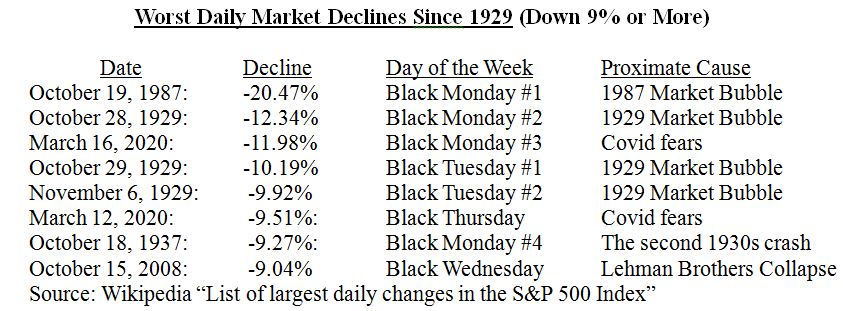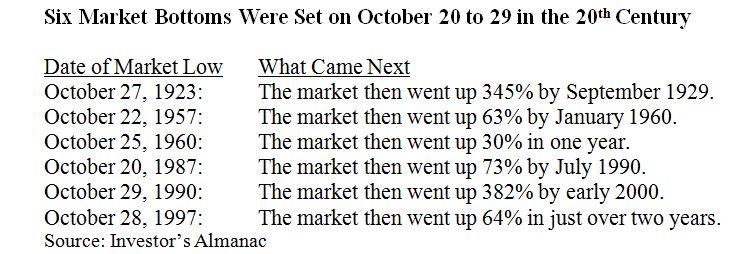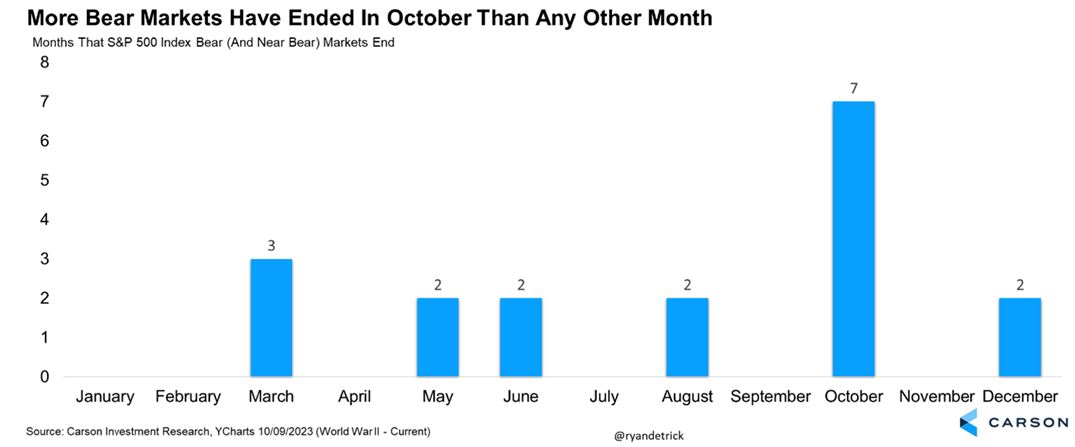by Gary Alexander
October 22, 2024
Thanksgiving is famous for “Black Friday” sales, but the “Black” designations began long ago – and they all came in September or October. Let me list them in historical order rather than in their weekly order:
September 24, 1869, was the first Black Friday, and it involved gold more than stocks. Jay Gould and his partner Jim Fisk cornered the gold market, forcing the Midas metal’s price up on the New York Gold Exchange during September 1869. The premium on gold rose to 69% by Black Friday, but Gould had secretly sold much of his gold, leaving Fisk holding the bag as the premium fell to 33% on Black Friday.
Black Thursday was October 24, 1929, the start of the 1929 market crash, and Black Tuesday came the following week, even though the intervening Monday (October 28th) was worse than the two Black days.
Black Monday came on October 19, 1987, when the Dow fell a then-record 508 points (and still-record 22.6%) on then-record volume (604,330,000 shares), almost twice the previous daily record, which was set the previous Friday. The market day began in Asia, where Monday opened in Singapore, with a 33% drop, a 17% loss in Tokyo and -11% in Hong Kong – which closed for the rest of the week. London fared worse, down 22%. Hearing this news over their breakfast coffee, New York traders sold from the get-go.
Black Wednesday was September 16, 1992, when the pound sterling crashed, forcing Britain to exit the European Exchange Rate Mechanism, after George Soros and others made a massive bet against the pound. In a way, this Big Bet closed our “Black Circle” in its resemblance to the Gold Corner of 1869.
Focusing on stocks, the market’s two worst days – and five of its eight worst days – all fell in October:

Even though October has been a positive month in the 21st century, memories are long about painful past Octobers, and not just the ancient Panics of 1907, 1929 or 1937. To many, the pains of 1987 still sting.
Most investors couldn’t get through to their brokers to sell that day. All circuits were busy. The next morning was even worse. Despite Monday’s record 508 Dow-point loss, there was no buying the next morning either, and then the Toronto gold index fell 22% as investors sold gold to meet margin calls.
More recently, on Thursday, October 23, 1997, the Dow fell 187 points (-2%), the second of four straight declines totaling 900 points (-11%), based on fears generated by the Asian Currency Crisis.
Black Monday, October 27, 1997, was the worst one-day point drop in market history to that date, in Dow points (-554 points, from 7715 to 7161). On a percentage basis, Black Monday #5 was the third worst daily decline since the 1930s (-7.2%), at that time, trailing only two Mondays in late October 1987.
Does This Make Late October the Best Time of Year to Buy?
After seeing all these terrible crashes in Octobers past, it’s good to remember that market lows in October are the first step toward dramatic recoveries in the winter months. Major bull markets often begin in late October. Here are some major 20th Century bull markets which began in late October (this very week):

In addition, a seventh, (2000-02) bear market also ended October 9, 2002. The market then rose 100% in five years. As a result, October gave birth to seven bull markets, vs. just 11 for the other 11 months combined:

Graphs are for illustrative and discussion purposes only. Please read important disclosures at the end of this commentary.
In the last two years, we’ve also seen two market panics in October. It’s not likely we’ll see such a “flash crash” again in the next 10 days, but it’s refreshing to review this history and know that it’s fairly certain that if we make it through the Black days of October – and a reasonably certain election result November 5th – we might see smooth sailing for the rest of 2024, since November is historically the strongest month of the year and the fourth quarter generally delivers more gains than the first three quarters combined.

In the last 34 years, since 1990, Jason Bodner has traced daily and monthly market data and found that November is the best performing month in all four major indexes – the Dow Jones Industrials, the S&P 500, the NASDAQ Composite and the Russell 2000. December and October are also positive enough so that the fourth quarter generally provides more average gains than the first three quarters combined.
For three of the four indexes (all but NASDAQ), the fourth quarter almost doubles the first three quarters:

Maybe the best news, as I reminded you here two weeks ago, is that the S&P 500 has rallied strongly in the last two (Trump) presidential election years – contentious ones, like this year – compared to the rather flat performances in the Octobers prior to those elections. This is the table I presented here on October 8th:

So, let’s just make it through the next 10 days of “Black” October fears, and a non-disputed Election, and it should be smooth sailing for the rest of 2024, with several uncertainties about 2025 finally laid to rest.
All content above represents the opinion of Gary Alexander of Navellier & Associates, Inc.
Also In This Issue
A Look Ahead by Louis Navellier
Future Electricity Demands Require a Massive Energy Infrastructure
Income Mail by Bryan Perry
This Election Cycle Holds Major Taxable Consequences
Growth Mail by Gary Alexander
If We Make It Through “Black October,” The Market Should Stabilize
Global Mail by Ivan Martchev
It’s Groundhog Day (Again) in the Stock Market
Sector Spotlight by Jason Bodner
Is This Overbought Market Overdue for a Correction?
View Full Archive
Read Past Issues Here
About The Author

Gary Alexander
SENIOR EDITOR
Gary Alexander has been Senior Writer at Navellier since 2009. He edits Navellier’s weekly Marketmail and writes a weekly Growth Mail column, in which he uses market history to support the case for growth stocks. For the previous 20-years before joining Navellier, he was Senior Executive Editor at InvestorPlace Media (formerly Phillips Publishing), where he worked with several leading investment analysts, including Louis Navellier (since 1997), helping launch Louis Navellier’s Blue Chip Growth and Global Growth newsletters.
Prior to that, Gary edited Wealth Magazine and Gold Newsletter and wrote various investment research reports for Jefferson Financial in New Orleans in the 1980s. He began his financial newsletter career with KCI Communications in 1980, where he served as consulting editor for Personal Finance newsletter while serving as general manager of KCI’s Alexandria House book division. Before that, he covered the economics beat for news magazines. All content of “Growth Mail” represents the opinion of Gary Alexander
Important Disclosures:
Although information in these reports has been obtained from and is based upon sources that Navellier believes to be reliable, Navellier does not guarantee its accuracy and it may be incomplete or condensed. All opinions and estimates constitute Navellier’s judgment as of the date the report was created and are subject to change without notice. These reports are for informational purposes only and are not a solicitation for the purchase or sale of a security. Any decision to purchase securities mentioned in these reports must take into account existing public information on such securities or any registered prospectus.To the extent permitted by law, neither Navellier & Associates, Inc., nor any of its affiliates, agents, or service providers assumes any liability or responsibility nor owes any duty of care for any consequences of any person acting or refraining to act in reliance on the information contained in this communication or for any decision based on it.
Past performance is no indication of future results. Investment in securities involves significant risk and has the potential for partial or complete loss of funds invested. It should not be assumed that any securities recommendations made by Navellier. in the future will be profitable or equal the performance of securities made in this report. Dividend payments are not guaranteed. The amount of a dividend payment, if any, can vary over time and issuers may reduce dividends paid on securities in the event of a recession or adverse event affecting a specific industry or issuer.
None of the stock information, data, and company information presented herein constitutes a recommendation by Navellier or a solicitation to buy or sell any securities. Any specific securities identified and described do not represent all of the securities purchased, sold, or recommended for advisory clients. The holdings identified do not represent all of the securities purchased, sold, or recommended for advisory clients and the reader should not assume that investments in the securities identified and discussed were or will be profitable.
Information presented is general information that does not take into account your individual circumstances, financial situation, or needs, nor does it present a personalized recommendation to you. Individual stocks presented may not be suitable for every investor. Investment in securities involves significant risk and has the potential for partial or complete loss of funds invested. Investment in fixed income securities has the potential for the investment return and principal value of an investment to fluctuate so that an investor’s holdings, when redeemed, may be worth less than their original cost.
One cannot invest directly in an index. Index is unmanaged and index performance does not reflect deduction of fees, expenses, or taxes. Presentation of Index data does not reflect a belief by Navellier that any stock index constitutes an investment alternative to any Navellier equity strategy or is necessarily comparable to such strategies. Among the most important differences between the Indices and Navellier strategies are that the Navellier equity strategies may (1) incur material management fees, (2) concentrate its investments in relatively few stocks, industries, or sectors, (3) have significantly greater trading activity and related costs, and (4) be significantly more or less volatile than the Indices.
ETF Risk: We may invest in exchange traded funds (“ETFs”) and some of our investment strategies are generally fully invested in ETFs. Like traditional mutual funds, ETFs charge asset-based fees, but they generally do not charge initial sales charges or redemption fees and investors typically pay only customary brokerage fees to buy and sell ETF shares. The fees and costs charged by ETFs held in client accounts will not be deducted from the compensation the client pays Navellier. ETF prices can fluctuate up or down, and a client account could lose money investing in an ETF if the prices of the securities owned by the ETF go down. ETFs are subject to additional risks:
- ETF shares may trade above or below their net asset value;
- An active trading market for an ETF’s shares may not develop or be maintained;
- The value of an ETF may be more volatile than the underlying portfolio of securities the ETF is designed to track;
- The cost of owning shares of the ETF may exceed those a client would incur by directly investing in the underlying securities; and
- Trading of an ETF’s shares may be halted if the listing exchange’s officials deem it appropriate, the shares are delisted from the exchange, or the activation of market-wide “circuit breakers” (which are tied to large decreases in stock prices) halts stock trading generally.
Grader Disclosures: Investment in equity strategies involves substantial risk and has the potential for partial or complete loss of funds invested. The sample portfolio and any accompanying charts are for informational purposes only and are not to be construed as a solicitation to buy or sell any financial instrument and should not be relied upon as the sole factor in an investment making decision. As a matter of normal and important disclosures to you, as a potential investor, please consider the following: The performance presented is not based on any actual securities trading, portfolio, or accounts, and the reported performance of the A, B, C, D, and F portfolios (collectively the “model portfolios”) should be considered mere “paper” or pro forma performance results based on Navellier’s research.
Investors evaluating any of Navellier & Associates, Inc.’s, (or its affiliates’) Investment Products must not use any information presented here, including the performance figures of the model portfolios, in their evaluation of any Navellier Investment Products. Navellier Investment Products include the firm’s mutual funds and managed accounts. The model portfolios, charts, and other information presented do not represent actual funded trades and are not actual funded portfolios. There are material differences between Navellier Investment Products’ portfolios and the model portfolios, research, and performance figures presented here. The model portfolios and the research results (1) may contain stocks or ETFs that are illiquid and difficult to trade; (2) may contain stock or ETF holdings materially different from actual funded Navellier Investment Product portfolios; (3) include the reinvestment of all dividends and other earnings, estimated trading costs, commissions, or management fees; and, (4) may not reflect prices obtained in an actual funded Navellier Investment Product portfolio. For these and other reasons, the reported performances of model portfolios do not reflect the performance results of Navellier’s actually funded and traded Investment Products. In most cases, Navellier’s Investment Products have materially lower performance results than the performances of the model portfolios presented.
This report contains statements that are, or may be considered to be, forward-looking statements. All statements that are not historical facts, including statements about our beliefs or expectations, are “forward-looking statements” within the meaning of The U.S. Private Securities Litigation Reform Act of 1995. These statements may be identified by such forward-looking terminology as “expect,” “estimate,” “plan,” “intend,” “believe,” “anticipate,” “may,” “will,” “should,” “could,” “continue,” “project,” or similar statements or variations of such terms. Our forward-looking statements are based on a series of expectations, assumptions, and projections, are not guarantees of future results or performance, and involve substantial risks and uncertainty as described in Form ADV Part 2A of our filing with the Securities and Exchange Commission (SEC), which is available at www.adviserinfo.sec.gov or by requesting a copy by emailing info@navellier.com. All of our forward-looking statements are as of the date of this report only. We can give no assurance that such expectations or forward-looking statements will prove to be correct. Actual results may differ materially. You are urged to carefully consider all such factors.
FEDERAL TAX ADVICE DISCLAIMER: As required by U.S. Treasury Regulations, you are informed that, to the extent this presentation includes any federal tax advice, the presentation is not written by Navellier to be used, and cannot be used, for the purpose of avoiding federal tax penalties. Navellier does not advise on any income tax requirements or issues. Use of any information presented by Navellier is for general information only and does not represent tax advice either express or implied. You are encouraged to seek professional tax advice for income tax questions and assistance.
IMPORTANT NEWSLETTER DISCLOSURE:The hypothetical performance results for investment newsletters that are authored or edited by Louis Navellier, including Louis Navellier’s Growth Investor, Louis Navellier’s Breakthrough Stocks, Louis Navellier’s Accelerated Profits, and Louis Navellier’s Platinum Club, are not based on any actual securities trading, portfolio, or accounts, and the newsletters’ reported hypothetical performances should be considered mere “paper” or proforma hypothetical performance results and are not actual performance of real world trades. Navellier & Associates, Inc. does not have any relation to or affiliation with the owner of these newsletters. There are material differences between Navellier Investment Products’ portfolios and the InvestorPlace Media, LLC newsletter portfolios authored by Louis Navellier. The InvestorPlace Media, LLC newsletters contain hypothetical performance that do not include transaction costs, advisory fees, or other fees a client might incur if actual investments and trades were being made by an investor. As a result, newsletter performance should not be used to evaluate Navellier Investment services which are separate and different from the newsletters. The owner of the newsletters is InvestorPlace Media, LLC and any questions concerning the newsletters, including any newsletter advertising or hypothetical Newsletter performance claims, (which are calculated solely by Investor Place Media and not Navellier) should be referred to InvestorPlace Media, LLC at (800) 718-8289.
Please note that Navellier & Associates and the Navellier Private Client Group are managed completely independent of the newsletters owned and published by InvestorPlace Media, LLC and written and edited by Louis Navellier, and investment performance of the newsletters should in no way be considered indicative of potential future investment performance for any Navellier & Associates separately managed account portfolio. Potential investors should consult with their financial advisor before investing in any Navellier Investment Product.
Navellier claims compliance with Global Investment Performance Standards (GIPS). To receive a complete list and descriptions of Navellier’s composites and/or a presentation that adheres to the GIPS standards, please contact Navellier or click here. It should not be assumed that any securities recommendations made by Navellier & Associates, Inc. in the future will be profitable or equal the performance of securities made in this report.
FactSet Disclosure: Navellier does not independently calculate the statistical information included in the attached report. The calculation and the information are provided by FactSet, a company not related to Navellier. Although information contained in the report has been obtained from FactSet and is based on sources Navellier believes to be reliable, Navellier does not guarantee its accuracy, and it may be incomplete or condensed. The report and the related FactSet sourced information are provided on an “as is” basis. The user assumes the entire risk of any use made of this information. Investors should consider the report as only a single factor in making their investment decision. The report is for informational purposes only and is not intended as an offer or solicitation for the purchase or sale of a security. FactSet sourced information is the exclusive property of FactSet. Without prior written permission of FactSet, this information may not be reproduced, disseminated or used to create any financial products. All indices are unmanaged and performance of the indices include reinvestment of dividends and interest income, unless otherwise noted, are not illustrative of any particular investment and an investment cannot be made in any index. Past performance is no guarantee of future results.
